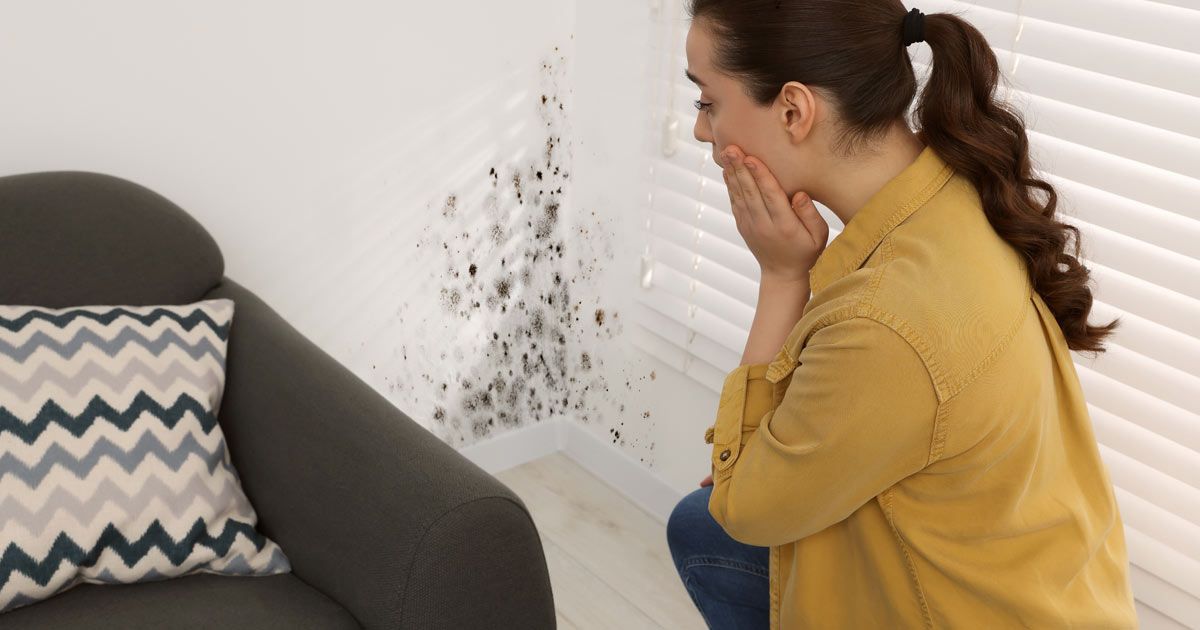Mold Toxicity Treatment NYC - Dr. John Salerno

Understanding and Overcoming Mold Poisoning with Medical Treatments by Salerno Wellness in Manhattan, NY, and Connecticut
I understand how debilitating and confusing the symptoms of mold toxicity can be, often leaving you feeling unheard and without answers while your quality of life declines. For over 30 years, I have seen firsthand how this condition can silently disrupt your health, and I want to reassure you that there is a path to recovery. My approach focuses on identifying and addressing the root cause of your illness, using a combination of complementary, functional, and integrative treatments designed to restore your vitality. Together, we can work to detoxify your body and help you reclaim the vibrant, healthy life you deserve..
-Dr. John Salerno
What is Mold Toxicity? Chronic Inflammatory Response Syndrome (CIRS)
Mold toxicity, also known as mold illness or Chronic Inflammatory Response Syndrome (CIRS), is a serious health condition that occurs when your body is overwhelmed by mycotoxins. These are toxic substances produced by certain types of mold found in water-damaged buildings. When inhaled, ingested, or absorbed through the skin, mycotoxins can trigger a widespread inflammatory reaction throughout the body.
Unlike a mold allergy, which is an immediate immune response to mold spores, mold toxicity is a systemic poisoning that can affect multiple organs and systems. The body's inability to properly detoxify these substances leads to a cascade of chronic symptoms that are often misdiagnosed. This inflammatory response can disrupt neurological, endocrine, and immune functions, creating a complex and persistent illness. For many, especially those with a genetic predisposition, the body cannot recognize and eliminate these toxins, allowing them to accumulate and cause long-term damage.
Common Symptoms of Mold Exposure
The symptoms of mold toxicity are often vague and can mimic many other conditions, making diagnosis a significant challenge. Because mycotoxins can impact nearly every system in the body, the range of potential symptoms is vast and varies greatly from person to person. You may experience a cluster of seemingly unrelated issues that have developed or worsened over time, leaving you feeling chronically unwell without a clear explanation.
- Fatigue and Weakness: This is not ordinary tiredness but a profound, persistent exhaustion that is not relieved by rest. Patients often describe feeling completely drained of energy, making it difficult to perform even simple daily tasks.
- Brain Fog and Cognitive Issues: You might struggle with memory loss, difficulty concentrating, and a general feeling of mental cloudiness. This cognitive impairment can affect your work performance, daily responsibilities, and overall mental clarity.
- Headaches and Light Sensitivity: Chronic, often severe headaches or migraines are a common complaint among those with mold toxicity. This is frequently accompanied by an unusual sensitivity to light, which can make being in brightly lit rooms or outdoors uncomfortable.
- Respiratory Problems: Persistent sinus congestion, a chronic cough, shortness of breath, or asthma-like symptoms can develop. These issues arise from the direct inhalation of mold spores and mycotoxins, which inflame the respiratory tract.
- Muscle and Joint Pain: Widespread aches, pains, and stiffness in muscles and joints are frequently reported. This pain can be migratory, moving from one area of the body to another, and is often mistaken for fibromyalgia or arthritis.
- Mood Swings and Anxiety: Mycotoxins can disrupt neurotransmitter function, leading to significant changes in mood. Many people experience increased anxiety, depression, irritability, and a general sense of emotional instability that feels out of character.
- Digestive Issues: Mold toxicity can harm the gut lining and disrupt the microbiome, causing symptoms like nausea, abdominal pain, diarrhea, and bloating. These gastrointestinal problems can further contribute to poor nutrient absorption and overall inflammation.
Common Causes of Mold Infections
The primary cause of mold toxicity is exposure to the indoor environment of a water-damaged building. Mold requires moisture to grow, so any building that has experienced a leak or flood, or that has high humidity, is at risk. Common sources of water intrusion include leaky roofs, faulty plumbing, condensation on windows, and poor ventilation in areas such as basements, crawl spaces, and bathrooms. Once mold begins to grow, it releases mycotoxins into the air, which can then circulate throughout the building's HVAC system.
This means you don’t have to see the mold for it to be a problem; it can be hidden behind walls, under flooring, or in ceiling tiles. Continuous exposure in a home, workplace, or school environment allows these toxins to accumulate in the body, eventually overwhelming its natural detoxification pathways and leading to chronic illness. A person's susceptibility can also be influenced by genetic factors that impair their ability to eliminate mycotoxins effectively.
Related Medical Conditions That Can Be Treated
Mold toxicity is often called "the great imitator" because its symptoms overlap with many other chronic conditions. This systemic illness can either trigger or significantly worsen other medical diagnoses, complicating the path to effective treatment. Dr. John Salerno specializes in identifying the underlying role of mold toxicity in these related conditions to provide comprehensive and targeted care.
- Chronic Fatigue Syndrome (CFS) - Many patients diagnosed with CFS are actually suffering from untreated mold toxicity. The profound, unrelenting fatigue and post-exertional malaise characteristic of CFS are hallmark symptoms of the body being burdened by mycotoxins.
- Fibromyalgia - The widespread muscle pain, joint stiffness, and tender points associated with fibromyalgia can be directly caused by the inflammatory effects of mycotoxins. By addressing the mold toxicity, many patients find significant relief from their fibromyalgia symptoms.
- Lyme Disease and Co-infections - Mold toxicity severely weakens the immune system, making the body more susceptible to infections like Lyme disease and its co-infections. Treating the mold exposure is a critical step in allowing the immune system to recover and effectively fight these persistent pathogens.
- Mast Cell Activation Syndrome (MCAS) - Mycotoxins are a major trigger of mast cell activation, leading to symptoms such as hives, flushing, digestive upset, and anaphylactic-like reactions. Stabilizing the mast cells and detoxifying from mold are essential for managing this condition.
- Autoimmune Diseases - The chronic inflammation caused by mold toxicity can contribute to the development or flare-ups of autoimmune conditions such as Hashimoto's thyroiditis, rheumatoid arthritis, and multiple sclerosis. Reducing the body's toxic load can help calm the overactive immune response.

Candidates for Mold Poisoning Treatments by Dr. John Salerno
Ideal candidates for mold treatment with Dr. John Salerno are individuals suffering from chronic, multi-symptom illnesses that have not responded to conventional medical approaches. These patients often have a history of living or working in a water-damaged environment and present with a confusing array of symptoms, including debilitating fatigue, brain fog, chronic pain, and respiratory issues. Many have been given diagnoses like fibromyalgia, chronic fatigue syndrome, or anxiety, yet the prescribed treatments have provided little to no relief.
Dr. Salerno's integrative methods are best suited for those seeking to identify and treat the root cause of their health problems rather than just managing symptoms. If you suspect your environment is making you sick and are looking for a comprehensive diagnostic and detoxification protocol, you are a strong candidate. This approach is for patients who are ready to take an active role in their recovery through a functional medicine partnership.
How Conventional Medicine Treats Mold Toxicity
Conventional medicine often struggles to diagnose and treat mold toxicity because the condition is not widely recognized or understood within its framework. Most traditionally trained doctors focus on treating individual symptoms rather than searching for a systemic, environmental cause. A patient presenting with sinus issues, headaches, and fatigue might be referred to an allergist, a neurologist, and a rheumatologist, with each specialist addressing only the symptom in their domain.
Treatment may involve prescribing allergy medications, antidepressants, or pain relievers, which can provide temporary relief but fail to address the underlying toxic burden. Conventional medicine typically does not test for mycotoxins in the body or connect a patient's symptoms to a water-damaged building. This symptomatic approach leaves the root cause of the illness—the ongoing exposure and accumulated toxins—untreated, allowing the patient's health to continue to decline.
How Dr. John Salerno Treats Mold Toxicity
Dr. John Salerno approaches mold toxicity with a comprehensive, multi-step functional medicine protocol designed to address the root cause of the illness. The first step is always to identify and eliminate the source of mold exposure, as no treatment can be successful if the patient continues to be exposed. Dr. Salerno then utilizes advanced laboratory testing to confirm the presence of mycotoxins in the body. Treatment focuses on supporting the body's natural detoxification pathways through a combination of targeted nutritional supplements, binders such as charcoal and clay to trap toxins in the gut, and lifestyle modifications.
A key component of his protocol is the use of intravenous therapies, including Phosphatidylcholine IV treatments, which help repair cell membranes damaged by mycotoxins and facilitate the removal of toxins from deep within the tissues. This integrative strategy also includes supporting the immune system, reducing systemic inflammation, and restoring gut health to help the body fully recover and build resilience.
Possible Side Effects of Treatment
While the goal of treatment is to restore health, the detoxification process can sometimes trigger temporary side effects, often referred to as a Herxheimer reaction. As mycotoxins are mobilized from tissues and organs for elimination, they can temporarily worsen symptoms. Patients may experience increased fatigue, headaches, body aches, or brain fog during the initial phases of treatment.
These reactions are generally a sign that the protocol is working and that toxins are being successfully removed from the body. Dr. John Salerno carefully monitors his patients and can adjust treatment protocols to manage these effects, ensuring the detoxification process is as gentle and tolerable as possible. The intensity of these side effects can be minimized by starting with low doses of binders and supplements and gradually increasing them as the body adapts.
What Can Happen if Mold Poisoning is Left Untreated?
If mold toxicity is left untreated, the chronic inflammation and toxic burden can lead to severe and progressive damage to multiple organ systems. The neurological effects can worsen, potentially leading to permanent cognitive decline, neuropathy, and an increased risk of neurodegenerative diseases like Parkinson's or dementia. The immune system becomes increasingly suppressed, leaving the body vulnerable to recurrent infections and potentially triggering autoimmune disorders.
Over time, the constant stress on the liver and kidneys can impair their function, while persistent inflammation may affect the cardiovascular system. The ongoing cellular damage can accelerate the aging process and significantly diminish one's quality of life, leading to long-term disability. Ultimately, failing to address the root cause allows the illness to become more entrenched and difficult to treat, resulting in a state of chronic, debilitating disease.
Patient Case Study for Treating Mold
Maria, a 42-year-old marketing executive, came to Dr. John Salerno after two years of declining health that baffled numerous specialists. She suffered from extreme fatigue, severe brain fog that impacted her ability to work, debilitating muscle pain, and persistent sinus infections. Her previous doctors had diagnosed her with fibromyalgia and chronic fatigue syndrome, but the treatments offered no improvement. During her consultation, Dr. Salerno learned that Maria’s health issues began shortly after she moved into a new apartment building. Suspecting an environmental cause, he ordered a urinary mycotoxin test, which revealed high levels of several mycotoxins, including trichothecenes and ochratoxin A.
Maria also had her apartment tested, which confirmed a significant hidden mold problem behind her bedroom wall. Dr. Salerno immediately started her on a comprehensive protocol that included moving out of the contaminated environment, using specific binders to remove toxins, and initiating Phosphatidylcholine IV therapy to repair cellular damage. Within three months, Maria’s brain fog began to lift, and her energy levels started to return. After six months of dedicated treatment, her muscle pain had vanished, and she felt like herself again for the first time in years.
Why Patients Choose Dr. John Salerno for Mold Treatments in NYC and CT
Patients choose Dr. John Salerno because of his extensive experience and his commitment to practicing root-cause medicine. With over 30 years in the field, he has a deep understanding of complex chronic illnesses, such as mold toxicity, that are often overlooked by conventional medicine. Patients who have felt dismissed or unheard find a true partner in Dr. Salerno, who listens carefully to their health history to uncover the underlying factors contributing to their condition.
His integrative approach combines the best of conventional diagnostics with advanced functional medicine therapies, offering a more complete and personalized path to wellness. He is renowned for his expertise in detoxification and intravenous nutrient therapies, which provide powerful tools for recovery. Patients value his thorough, evidence-based methods and his dedication to not just managing symptoms, but truly healing the body and restoring long-term health and vitality.
Contact Dr. John Salerno For A Consultation on Overcoming Mold Toxicity in Manhattan, NY, and Connecticut
Mold toxicity is a complex and serious condition caused by exposure to mold toxins in water-damaged buildings, leading to widespread inflammation and a range of chronic symptoms. Unlike conventional medicine, which often treats symptoms rather than identifying the root cause, Dr. John Salerno uses a functional medicine approach to diagnose and treat the underlying cause of your illness.
Through advanced testing and a personalized protocol that includes removing the source of exposure, using binders, and implementing therapies such as Phosphatidylcholine IV treatments, he helps patients detoxify and heal. This comprehensive strategy supports the body's natural ability to recover from the systemic damage caused by mycotoxins. If you are struggling with unexplained chronic symptoms and suspect mold could be the cause, do not continue to suffer without answers. Take the first step toward reclaiming your health. Contact Salerno Wellness today to schedule a consultation with Dr. John Salerno in Manhattan, NY, or Connecticut.
Please contact us today.
Additional References
- Mold - Centers for Disease Control and Prevention
- Mold and Health - Environmental Protection Agency



